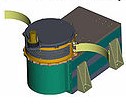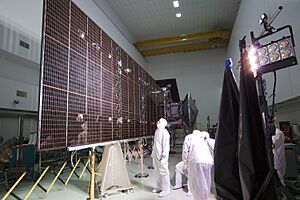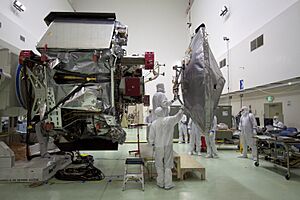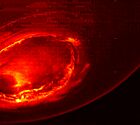Juno (spacecraft) facts for kids

Artist's rendering of the Juno spacecraft
|
|
| Names | New Frontiers 2 |
|---|---|
| Mission type | Jupiter orbiter |
| Operator | NASA / Jet Propulsion Laboratory |
| Website |
|
| Mission duration | Planned: 7 years Elapsed: 14 years, 4 months, 6 days Cruise: 4 years, 10 months, 29 days Science phase: 4 years, 4 months and 12 days (in progress; extended until September 2025) |
| Spacecraft properties | |
| Manufacturer | Lockheed Martin Space |
| Launch mass | 3,625 kg (7,992 lb) |
| Dry mass | 1,593 kg (3,512 lb) |
| Dimensions | 20.1 × 4.6 m (66 × 15 ft) |
| Power | 14 kW at Earth, 435 W at Jupiter 2 × 55-ampere hour lithium-ion batteries |
| Start of mission | |
| Launch date | August 5, 2011, 16:25:00 UTC |
| Rocket | Atlas V 551 (AV-029) |
| Launch site | Cape Canaveral, SLC-41 |
| Contractor | United Launch Alliance |
| Flyby of Earth | |
| Closest approach | October 9, 2013 |
| Distance | 559 km (347 mi) |
| Jupiter orbiter | |
| Orbital insertion | July 5, 2016, 9 years, 5 months, 7 days ago |
| Orbits | 76 (planned) |
| Orbit parameters | |
| Perijove | 4,200 km (2,600 mi) altitude 75,600 km (47,000 mi) radius |
| Apojove | 8.1×106 km (5.0×106 mi) |
| Inclination | 90° (polar orbit) |
 Juno mission patch New Frontiers
|
|
The Juno spacecraft is a NASA space probe that orbits the giant planet Jupiter. It was built by Lockheed Martin and is operated by NASA's Jet Propulsion Laboratory. Juno launched from Cape Canaveral Air Force Station on August 5, 2011. It is part of the New Frontiers program, which sends probes to explore different parts of our Solar System.
Juno arrived at Jupiter and entered a special polar orbit on July 5, 2016. Its main job is to study Jupiter up close. Scientists want to learn about Jupiter's makeup, its gravity, its magnetic field, and the area around its poles called the polar magnetosphere. The mission also looks for clues about how Jupiter formed. This includes trying to find out if it has a rocky core, how much water is deep in its atmosphere, and how its strong winds move. These winds can blow at speeds of up to 620 kilometers per hour (about 385 miles per hour)!
Juno is the second spacecraft to orbit Jupiter. The first was the Galileo orbiter, which explored Jupiter from 1995 to 2003. Unlike many other spacecraft that travel far into the outer Solar System and use nuclear power, Juno uses solar panels. These are more common for satellites orbiting Earth or working closer to the Sun. Because Jupiter is so far from the Sun, Juno needed the largest solar panels ever used on a planetary probe when it launched. These huge panels help keep the spacecraft stable and provide all its power.
Contents
Why is it Called Juno?
Juno's name comes from Greek and Roman mythology. The god Jupiter drew a veil of clouds around himself to hide his mischief, and his wife, the goddess Juno, was able to peer through the clouds and reveal Jupiter's true nature.
The name Juno comes from ancient Roman myths. In these stories, the god Jupiter would hide himself behind clouds. But his wife, the goddess Juno, could see through the clouds and discover his true self. This is like the spacecraft, which is designed to "see through" Jupiter's thick clouds to learn its secrets.
Sometimes, Juno is also called New Frontiers 2. This is because it's the second mission in NASA's New Frontiers program.
Mission Overview
Juno was chosen for the New Frontiers program on June 9, 2005. Before Juno, scientists really wanted to send a probe to Jupiter, but no missions had been approved for a while.
Juno took five years to travel to Jupiter, arriving on July 5, 2016. The spacecraft traveled about 2.8 billion kilometers (1.7 billion miles) to get there. It was designed to orbit Jupiter 37 times. This was originally planned to take about 20 months.
To get a speed boost, Juno used a gravity assist from Earth. This happened during an Earth flyby in October 2013, two years after its launch. When Juno reached Jupiter, it fired its engine to slow down and enter Jupiter's orbit.
The mission was originally set to end in February 2018. However, it has been extended multiple times. In January 2021, NASA extended the mission until September 2025. This allows Juno to study Jupiter's large moons: Ganymede, Europa, and Io. Juno flew very close to Ganymede on June 7, 2021, and Europa on September 29, 2022. It also had close flybys of Io on December 30, 2023, and February 3, 2024.
Journey to Jupiter
Launching into Space
Juno launched on an Atlas V rocket from Cape Canaveral Space Force Station in Florida. This happened on August 5, 2011, at 16:25 UTC. The rocket used a powerful main engine and five solid rocket boosters to lift off.
After the boosters fell away, a protective cover called the payload fairing separated. This cover kept Juno safe during its trip through Earth's atmosphere. Then, the Atlas V main engine shut off, and the Centaur second stage ignited. This stage fired twice, first putting Juno into a parking orbit around Earth, and then pushing it onto a path to escape Earth's gravity and head towards the Sun.
Before separating from the Centaur stage, Juno was spun up to 1.4 rotations per minute. This spin helps keep the spacecraft stable during its long journey. About 54 minutes after launch, Juno separated and began to unfold its large solar panels. Once the panels were fully open, Juno's batteries started recharging.
Earth Flyby and Speed Boost
After traveling for about a year, Juno fired its engine twice to change its path. This brought it back to Earth for a close flyby on October 9, 2013. This maneuver, called a gravity assist, used Earth's gravity to give Juno a huge speed boost. It increased Juno's speed by more than 3.9 kilometers per second (about 8,700 miles per hour), sending it on its way to Jupiter. This flyby also allowed the Juno team to test some of the spacecraft's instruments.
Arriving at Jupiter
Jupiter's strong gravity pulled Juno in, speeding it up to about 210,000 kilometers per hour (130,000 miles per hour). On July 5, 2016, Juno fired its engine for over 2,100 seconds. This slowed it down enough to be captured by Jupiter's gravity. The spacecraft successfully entered an elliptical, polar orbit around Jupiter.
Orbiting Jupiter
Juno's orbit is very stretched out. It comes as close as 4,200 kilometers (2,600 miles) to Jupiter's cloud tops and then swings out as far as 8.1 million kilometers (5 million miles). This special orbit helps Juno avoid Jupiter's intense radiation belts. These belts can damage spacecraft electronics and solar panels.
To protect its sensitive electronics, Juno has a special "Juno Radiation Vault." This vault has 1-centimeter-thick titanium walls, which reduce the radiation by 800 times. Even with this protection, the radiation is very strong.
How Juno Works

Juno completed its first close flyby of Jupiter on August 26, 2016. It captured the first images of Jupiter's north pole.
On October 14, 2016, some of Juno's helium valves didn't open correctly. A few days later, Juno went into "safe mode." This means its computer detected a problem and powered down non-essential systems to protect itself. Because of this, no science data was collected during its second close approach. However, the mission team fixed the issue, and by December 11, 2016, most instruments were working again.
The mission was extended in June 2018 and again in January 2021. This allowed Juno to continue its studies until September 2025. During this extended phase, Juno has been making close flybys of Jupiter's largest moons: Ganymede, Europa, and Io. These flybys help scientists learn more about these fascinating worlds.
Planned End of Mission
NASA originally planned for Juno to intentionally crash into Jupiter's atmosphere after its mission. This is done to prevent any chance of the spacecraft accidentally hitting one of Jupiter's moons, especially Europa, which might have conditions suitable for life. This process helps avoid contaminating the moons with any tiny Earth microbes that might have survived on the spacecraft. However, with the mission extensions, the deorbit date has been pushed back.
The Juno Team
The Juno mission involves many talented people. Scott Bolton from the Southwest Research Institute is the main scientist in charge. The Jet Propulsion Laboratory in California manages the mission, and Lockheed Martin built the spacecraft. Many other scientists and institutions also help with the mission.
Mission Cost
The Juno mission was originally estimated to cost about $700 million in 2003. By 2019, the total cost for operations and data analysis through 2022 was projected to be $1.46 billion.
What Juno Studies

Juno's science instruments are designed to answer big questions about Jupiter:
- Water in Jupiter: It measures how much water is in Jupiter's atmosphere. This helps scientists understand how Jupiter and the rest of the Solar System formed.
- Jupiter's Core: It tries to figure out the mass of Jupiter's core. This also helps with theories about the planet's formation.
- Gravity and Mass: It precisely maps Jupiter's gravitational field. This shows how mass is spread out inside Jupiter, giving clues about its structure.
- Magnetic Field: It maps Jupiter's magnetic field to understand where it comes from and how deep inside the planet it is created.
- Atmosphere: It studies the different layers of Jupiter's atmosphere, including its temperature, clouds, and how its winds move.
- Polar Lights: It explores the 3D structure of Jupiter's polar magnetosphere and its amazing auroras (like the Northern and Southern Lights on Earth).
Science Tools on Juno
Juno carries nine special instruments to achieve its goals:
Microwave Radiometer (MWR)
This instrument has six antennas that measure microwave energy. Microwaves can pass through Jupiter's thick atmosphere. The MWR measures water and ammonia deep in the atmosphere, up to 500-600 kilometers (310-370 miles) deep. This helps scientists understand how deep the atmospheric circulation goes.
Jovian Infrared Auroral Mapper (JIRAM)
JIRAM is a camera that sees in near infrared light. It studies the upper layers of Jupiter's atmosphere. It also takes pictures of Jupiter's auroras. By measuring heat from the atmosphere, JIRAM can see how clouds with water move beneath the surface. It can also detect gases like methane and ammonia.
Magnetometer (MAG)
The MAG instrument measures Jupiter's magnetic field. It helps map the field's strength and direction. This tells scientists about the inside of Jupiter and the structure of its polar magnetosphere.
Gravity Science (GS)
This experiment measures Jupiter's gravity. Small changes in gravity affect Juno's speed as it orbits. By detecting these tiny speed changes using radio waves sent to Earth, scientists can create a map of how mass is distributed inside Jupiter.
Jovian Auroral Distributions Experiment (JADE)
JADE is a particle detector. It measures low-energy ions and electrons in Jupiter's auroras. This helps scientists understand the particles that create the stunning light shows at Jupiter's poles.
Jovian Energetic Particle Detector Instrument (JEDI)
JEDI also detects energetic particles, but at higher energies than JADE. It measures ions and electrons in Jupiter's polar magnetosphere. This helps scientists study how these particles behave in Jupiter's powerful magnetic environment.
Radio and Plasma Wave Sensor (Waves)
This instrument has two antennas that detect radio and plasma waves. It helps identify the regions where auroral currents flow and how particles are sped up to create Jupiter's radio emissions and auroras. It also observes how Jupiter's atmosphere and magnetosphere interact.
Ultraviolet Spectrograph (UVS)
UVS records ultraviolet light. It provides images of the UV light coming from Jupiter's auroras in the polar magnetosphere. This helps scientists understand the processes that cause these lights.
JunoCam (JCM)
JunoCam is a visible light camera. It was originally included for public outreach, but it's now also used to study Jupiter's clouds, especially those at the poles. Even though it was expected to last only about eight orbits due to radiation, JunoCam is still working well after more than 55 orbits!
Juno's Design
Solar Panels
Juno is the first mission to Jupiter to use solar panels instead of nuclear power. Even though Jupiter is far from the Sun, solar panel technology has improved a lot. Juno has three huge solar panels, each about 2.7 by 8.9 meters (9 by 29 feet). Together, they have 50 square meters (538 square feet) of solar cells. These were the largest solar panels ever on a NASA deep-space probe when Juno launched.
At Jupiter, Juno receives only about 4% of the sunlight it would get at Earth. The panels generate about 435 watts of power. Two large lithium-ion batteries store power for when Juno passes through Jupiter's shadow.
Communication
Juno communicates with Earth using large antennas from NASA's NASA Deep Space Network. It sends data back using X-band radio waves. The spacecraft's computer can send about 50 megabits of instrument data per second.
Because of communication limits, Juno can only send back about 40 megabytes of JunoCam images during each 11-day orbit. This means it sends between 10 and 100 images per orbit, depending on how much they are compressed. The main focus is on sending back scientific data from the other instruments.
Propulsion System
Juno uses a main engine for big maneuvers, like entering Jupiter's orbit. It also has twelve smaller thrusters. These small thrusters are used to control the spacecraft's direction and make small adjustments to its path.
Special Items on Juno
Galileo Plaque and Minifigures

Juno carries a special plaque dedicated to Galileo Galilei, a famous scientist. The plaque is made of aluminum and has a picture of Galileo. It also has text in Galileo's own handwriting from 1610. This text describes his observations of Jupiter's moons, which he was the first to see.
The spacecraft also carries three special Lego minifigures! These minifigures represent Galileo Galilei, the Roman god Jupiter, and the goddess Juno. The Juno minifigure holds a magnifying glass, showing her search for truth. Jupiter holds a lightning bolt. Galileo has his telescope. These special Lego figures are made of aluminum so they can survive the harsh conditions of space. They are part of a program to get kids interested in science, technology, engineering, and mathematics (STEM).
Discoveries and Results
Juno has already made many exciting discoveries about Jupiter. For example, it found new information about lightning on Jupiter, changing earlier ideas. It also gave us the first views of Jupiter's north pole and new insights into its auroras, magnetic field, and atmosphere.
In 2021, Juno helped scientists learn that the dust causing the Zodiacal light (a faint glow in the night sky) actually comes from Mars, not from comets or asteroids as previously thought.
Juno's findings are challenging existing ideas about how Jupiter formed. When it flew over Jupiter's poles, it saw stable clusters of cyclones. It also found that Jupiter's magnetosphere is uneven and chaotic. Using its Microwave Radiometer, Juno discovered that Jupiter's famous red and white bands extend hundreds of kilometers deep into the atmosphere. However, the inside of Jupiter is not evenly mixed. This has led to a new idea that Jupiter might not have a solid core. Instead, it might have a "fuzzy" core made of pieces of rock and metallic hydrogen. This unusual core might be the result of a collision that happened early in Jupiter's history.
In April 2020, Juno even detected a meteor impact on Jupiter!
Juno's studies of Jupiter's storms show they are much taller than expected. Some storms go 100 kilometers (60 miles) below the cloud tops. The famous Great Red Spot extends over 350 kilometers (200 miles) deep! By flying low over Jupiter's clouds, Juno could measure tiny changes in velocity. This helped scientists figure out that the Great Red Spot goes about 500 kilometers (300 miles) below the cloud tops. The new results also show that cyclones are warmer at the top and colder at the bottom, while anticyclones are colder at the top and warmer at the bottom.
Mission Timeline
| Date (UTC) | Event | Latitude (centric) | Longitude (Sys. III) |
|---|---|---|---|
| August 5, 2011, 16:25:00 | Launched | ||
| August 5, 2012, 06:57:00 | Deep Space Maneuvers (engine firings to change path) | ||
| September 3, 2012, 06:30:00 | |||
| October 9, 2013, 19:21:00 | Earth gravity assist (speed boost) | ||
| July 5, 2016, 03:53:00 | Arrived at Jupiter and entered orbit. | 3° | 30° |
| August 27, 2016, 12:50:44 | Perijove 1 (first close pass by Jupiter) | 4° | 100° |
| October 19, 2016, 18:10:53 | Perijove 2: Planned engine burn did not happen due to a valve issue. | 5° | 350° |
| December 11, 2016, 17:03:40 | Perijove 3 | 6° | 10° |
| February 2, 2017, 12:57:09 | Perijove 4 | 7° | 270° |
| March 27, 2017, 08:51:51 | Perijove 5 | 8° | 180° |
| May 19, 2017, 06:00:47 | Perijove 6 | 8° | 140° |
| July 11, 2017, 01:54:42 | Perijove 7: Flew over the Great Red Spot. | 9° | 50° |
| September 1, 2017, 21:48:50 | Perijove 8 | 10° | 320° |
| October 24, 2017, 17:42:31 | Perijove 9 | 11° | 230° |
| December 16, 2017, 17:56:59 | Perijove 10 | 12° | 300° |
| February 7, 2018, 13:51:49 | Perijove 11 | 13° | 210° |
| April 1, 2018, 09:45:57 | Perijove 12 | 14° | 110° |
| May 24, 2018, 05:40:07 | Perijove 13 | 15° | 20° |
| July 16, 2018, 05:17:38 | Perijove 14 | 16° | 70° |
| September 7, 2018, 01:11:55 | Perijove 15 | 17° | 340° |
| October 29, 2018, 21:06:15 | Perijove 16 | 17° | 250° |
| December 21, 2018, 17:00:25 | Perijove 17 | 18° | 160° |
| February 12, 2019, 16:19:48 | Perijove 18 | 19° | 240° |
| April 6, 2019, 12:13:58 | Perijove 19 | 20° | 100° |
| May 29, 2019, 08:08:13 | Perijove 20 | 20° | 10° |
| July 21, 2019, 04:02:44 | Perijove 21 | 21° | 280° |
| September 12, 2019, 03:40:47 | Perijove 22 | 22° | 320° |
| November 3, 2019, 23:32:56 | Perijove 23 | 22° | 190° |
| December 26, 2019, 16:58:59 | Perijove 24: Distant Ganymede flyby. | 23° | 70° |
| February 17, 2020, 17:51:36 | Perijove 25 | 23° | 140° |
| April 10, 2020, 14:24:34 | Perijove 26 | 24° | 50° |
| June 2, 2020, 10:19:55 | Perijove 27 | 25° | 340° |
| July 25, 2020, 06:15:21 | Perijove 28 | 25° | 250° |
| September 16, 2020, 02:10:49 | Perijove 29 | 26° | 160° |
| November 8, 2020, 01:49:39 | Perijove 30 | 27° | 210° |
| December 30, 2020, 21:45:12 | Perijove 31 | 27° | 120° |
| February 21, 2021, 17:40:31 | Perijove 32 | 28° | 30° |
| April 15, 2021, 13:36:26 | Perijove 33 | 29° | 300° |
| June 8, 2021, 07:46:00 | Perijove 34: Ganymede flyby (1,038 km from surface). Orbit period changed from 53 to 43 days. | 28° | 290° |
| July 21, 2021, 08:15:05 | Perijove 35: End of first mission extension. | 29° | 300° |
| September 2, 2021 | Perijove 36 | 30° | 100° |
| October 16, 2021 | Perijove 37 | 31° | 40° |
| November 29, 2021 | Perijove 38 | 31° | 80° |
| January 12, 2022 | Perijove 39 | 32° | 90° |
| February 25, 2022 | Perijove 40 | 33° | 280° |
| April 9, 2022 | Perijove 41 | 34° | 60° |
| May 23, 2022 | Perijove 42 | 35° | 70° |
| July 5, 2022 | Perijove 43 | 36° | 310° |
| August 17, 2022 | Perijove 44 | 37° | 150° |
| September 29, 2022, 09:36 | Perijove 45: Europa flyby (352 km from surface). Orbit period changed from 43 to 38 days. | 37° | 230° |
| November 6, 2022 | Perijove 46 | 38° | 350° |
| December 15, 2022 | Perijove 47: Io flyby on Dec 14, 2022 (64,000 km from surface). | 39° | 160° |
| January 22, 2023 | Perijove 48 | 40° | 200° |
| March 1, 2023 | Perijove 49 | 41° | 170° |
| April 8, 2023 | Perijove 50 | 42° | 210° |
| May 16, 2023 | Perijove 51 | 43° | 140° |
| June 23, 2023 | Perijove 52 | 44° | 80° |
| July 31, 2023 | Perijove 53: Io flyby on July 30, 2023 (22,000 km from surface). | 45° | 120° |
| September 7, 2023 | Perijove 54 | 45° | 190° |
| October 15, 2023 | Perijove 55 | 46° | 110° |
| November 22, 2023 | Perijove 56 | 47° | 120° |
| December 30, 2023 | Perijove 57: Io flyby (1,500 km from surface). | 47° | 90° |
| February 3, 2024 | Perijove 58: Io flyby (1,500 km from surface). Orbit period changed from 38 to 33 days. | 48° | 290° |
| March 7, 2024 | Perijove 59: Distant Amalthea flyby (117,500 km). | 49° | 0° |
| April 9, 2024 | Perijove 60 | 50° | 40° |
| May 12, 2024 | Perijove 61 | 51° | 250° |
| June 14, 2024 | Perijove 62 | 52° | 60° |
| July 17, 2024 | Perijove 63 | 53° | 260° |
| August 18, 2024 | Perijove 64 | 54° | 40° |
| September 20, 2024 | Perijove 65 | 55° | 240° |
| October 23, 2024 | Perijove 66 | 56° | 20° |
| November 25, 2024 | Perijove 67 | 57° | 120° |
| December 28, 2024 | Perijove 68 | 57° | 310° |
| January 30, 2025 | Perijove 69 | 58° | 110° |
| March 4, 2025 | Perijove 70: Thebe flyby on March 2, 2025 (31,780 km). | 59° | 0° |
| April 5, 2025 | Perijove 71 | 60° | 210° |
| May 8, 2025 | Perijove 72 | 61° | 50° |
| June 10, 2025 | Perijove 73 | 62° | 320° |
| July 13, 2025 | Perijove 74 | 63° | 180° |
| August 15, 2025 | Perijove 75 | 63° | 80° |
| September 17, 2025 | Perijove 76: End of second mission extension. | 64° | 320° |
Images for kids
Jupiter Views
-
Close-up of the Great Red Spot (July 11, 2017).
-
The Great Red Spot as seen by JunoCam (April 2018).
Moon Views
-
Low resolution view of Io captured by JunoCam (September 2017).
See also
 In Spanish: Juno (sonda espacial) para niños
In Spanish: Juno (sonda espacial) para niños
- Atmosphere of Jupiter
- Exploration of Jupiter
- List of missions to the outer planets
- Moons of Jupiter









































